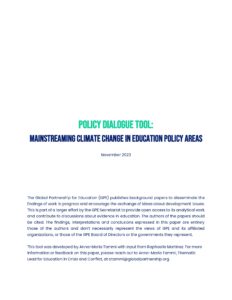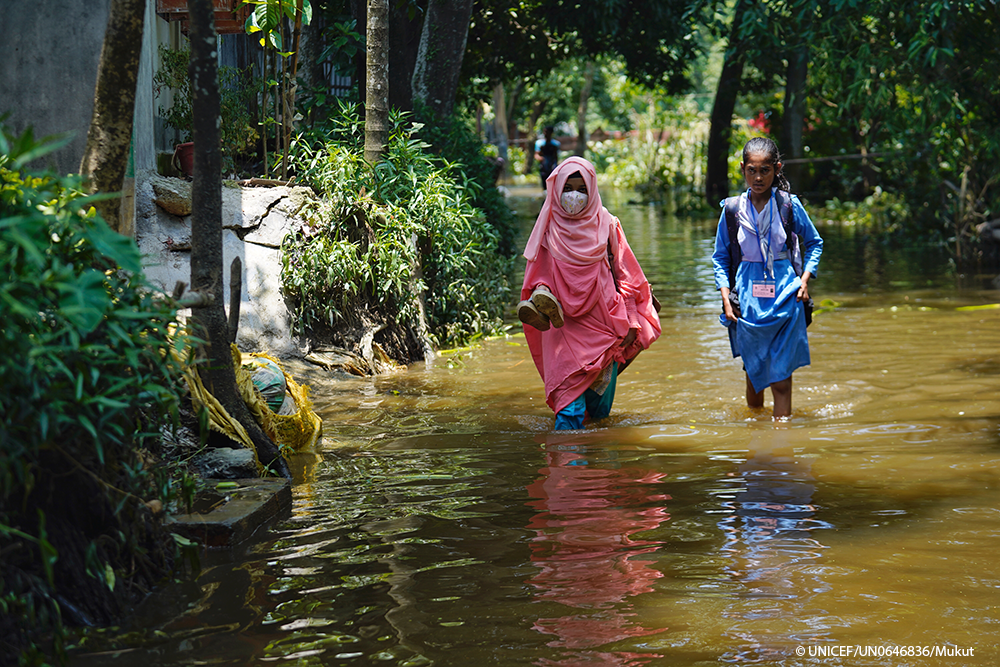Mainstreaming Climate Change in Education: Introducing a Tool for Policy Dialogue
In this blogpost, which is cross-posted with the GPE, Anna-Maria Tammi highlights a policy dialogue tool for mainstreaming climate change in education.
Climate change poses a significant threat to our planet and its inhabitants, leading to an urgency to integrate climate change into dialogue on public policy, including on education. While targeted policies for education, climate change and disaster risk are important, climate change is increasingly becoming everyone’s business and needs to be considered in the design of all education policies, whether they be focused on access, learning or inclusion.
A quick guide, not a detailed guideline
 Recognizing the crucial role of education to address climate change, the Global Partnership for Education (GPE) has developed a policy dialogue tool for mainstreaming climate change in education policies and practices. The tool helps partners embed climate change considerations within partnership compacts (that identify partner countries’ priority education reforms), GPE-funded grants and broader education sector dialogue.
Recognizing the crucial role of education to address climate change, the Global Partnership for Education (GPE) has developed a policy dialogue tool for mainstreaming climate change in education policies and practices. The tool helps partners embed climate change considerations within partnership compacts (that identify partner countries’ priority education reforms), GPE-funded grants and broader education sector dialogue.
The tool draws from GPE’s framework for climate-smart education systems as well as evidence reviews on climate change and resilience, and is organized by the 8 priority areas of the GPE 2025 strategic plan: access, learning (including early learning), teaching, inclusion, gender equality, domestic financing and strong organizational capacity. Here we focus on learning and inclusion as examples.
Accounting for climate change impacts on learning
Policymakers and practitioners can integrate climate change topics into formal curricula and student assessments, but there are other entry points when designing strategies for learning.
One of them is the physical learning environment. The need for disaster-resistant school buildings in regions that suffer from storms, cyclones or monsoons is well known. However, there is increasing recognition of the negative associations between learning and the long-term effects of climate change.
Slow-onset phenomena like gradually increasing temperatures and changing rainfall patterns can result in increased student absenteeism, weaker physical and delayed cognitive development in children, and poorer academic performance.
Studies show the detrimental impact of excess heat on test scores, with a drop in learning achievement up to 1 percent for every 0.55°C increase in temperature. Extreme weather events have also been found to lower academic performance.
To counter such effects, actions need to be taken to reduce teacher and student exposure to excessive heat while at school. Measures to passively cool school buildings include painting building facades in white or light colors, providing adequate ventilation (natural ventilation, ceiling fans), planting trees for shade and installing green or living roofs.
Climate considerations are also needed for education policies focused on the youngest, given that climate change, environmental degradation and disasters greatly impact young children and hinder their cognitive and physical development. For example, young children are more susceptible to diseases that spread with climate change, like malaria.
To adequately support young children throughout climate change, it’s imperative to identify their needs across developmental stages, including impacts on mothers during conception and pregnancy.
Quality early childhood programs are also critical for climate resilience and climate action as they can provide an important basis to build resilience and adaptability. Early childhood programs can support climate change mitigation with environmentally friendly facilities, transportation systems and green play spaces that foster a new generation with the skills and knowledge to safeguard the environment.
Leaving no one behind in an era of climate impacts
When designing policies for inclusion at large, whether for persons with disabilities or children living in fragile and conflict-affected contexts, the effects of climate change must be considered or policymakers risk leaving some children behind. The meaningful participation, inclusion and leadership of representatives of affected communities in designing such policies is also essential.
Persons with disabilities are often among those most adversely affected in an emergency, sustaining disproportionately higher rates of mortality and being among those least able to access support. Children living in conflict-affected countries are also particularly vulnerable to climate change, both because of its environmental impacts and limited government capacity to mitigate risks. Of the 20 countries considered most vulnerable to climate change by the Notre Dame–Global Adaptation Initiative (ND-GAIN) Index, 60% are affected by armed conflict.
By 2050, climate change could lead to as many as 216 million people being internally displaced. It’s important to recognize displacement patterns vary widely across the world. In Asia and the Pacific, populations move during climatic seasons whereas people in the Caribbean experience temporary displacement following hurricanes and storms. In East Africa, people sign up in refugee camps due to droughts and floods.
Because climate displacement differs by region, so do the barriers to education, whether destruction of school infrastructure, language barriers or loss of livelihoods.
In 2024 alone, schools have closed due to excessive heat waves in South Sudan, the Philippines and India, with other countries reducing the length of school days due to unsustainable temperatures for classroom teaching. Education needs to continue at a distance during such periods, but the take-up of distance learning is hindered by preexisting inequities. The design of distance learning needs to start with reaching the most marginalized and the youngest learners first.
No time to wait
Integrating climate change considerations in education is crucial not just for building a sustainable future, but for protecting education and the rights of children right now.
We are rapidly moving towards a reality where all of us must speak the language of climate risks and think about how those risks will affect the success of policies designed for the education sector. This tool aims to provide some ideas towards that and we hope it can be helpful for jump-starting conversations on embedding climate considerations across education policies.
For further reading, including more detailed technical guidance, please consult these resources from partners on crisis-sensitive planning, risk-informed programming and school safety.
About the Author:
Anna-Maria Tammi is Senior Thematic Lead for Equity & Inclusion at Global Partnership for Education.

